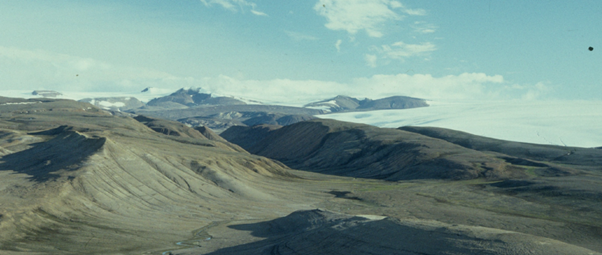Far above the Arctic Circle, the stumps of old trees are so large they were first spotted from an aircraft, looking completely incongruous on an island where little grows, let alone great trees. A study of these trees’ nuts has offered insight into the world 45 million years ago, when the Arctic was a much more appealing place, as well as revealing three species of walnut unknown anywhere else.
The trees are located on Axel Heiberg, Canada’s seventh-largest island. The reason few people outside Canada have heard of it is that it’s further north than almost all of Greenland; it’s so cold even the Inuit had abandoned it by the time European explorers got there. Today the main reasons anyone visits include practicing surviving on Mars, along with studying Global Heating.
The other primary attraction is a fossil forest of what were once mighty trees, the stumps and roots of which have been preserved from 45 million years ago.
“When you walk into the site, the first thing you notice are these big stumps, a meter or more in diameter, and they’re still rooted in the soil that they grew in. It’s completely out of place. The closest living trees are 3,000 kilometers [1,864 miles] away,” said Professor James Basinger of the University of Saskatchewan in a statement.
Looking at the Axel Heiberg’s landscape it’s hard to believe there were ever forests here.
Image Credit: James Basinger
The stumps are remnants of trees that thrived there during the Eocene epoch, when the world was a great deal warmer. Average annual temperatures just 11 degrees from the pole are thought to have been more than 10°C (50°F), thanks to high atmospheric carbon dioxide. Nevertheless, Arctic winters were just as dark. Consequently, the island provides an indication of what forests could look like under conditions when summers are warm enough to allow them, but there is no sunlight for months at a time. It’s something we might see again in not too long.
The early Eocene was one of the warmest times in the history of the planet, thanks to much higher, but not precisely measured carbon dioxide levels.
Image Credit: GLEN FERGUS, CC BY-SA
We have evidence that dinosaurs made their home in forests in Antarctica tens of millions of years earlier, but much less information about what those forests were like.
“There aren’t really that many places around where you can go to see fossils that are preserved that well,” said Dr Steven Manchester of the Florida Museum of Natural History.
The trees and their nuts are so well preserved because they have been mummified, rather than undergoing more common forms of fossilization. No ancient Egyptian intervention was required; the forest was buried beneath a swamp before bacteria or fungi could decompose its trees.
The researchers found nuts eroding from the soil, making it very easy to identify the genus of the trees, even if they couldn’t be matched to known species. In a testimony to the extraordinary preservation, Basinger noted; “In one case, the walnuts are concentrated at one spot, possibly cached there by animals.” Some arctic proto-squirrel was really not ready for the multi-million-year winter to come.
Although CT scans allowed botanists to look inside without damaging them, some were so brittle they broke open anyway.
Image Credit: James Basinger
Axel Heiberg’s forests reveal is now Canadian tundra and the Greenland ice cap had forests like the mighty redwoods of the American west coast, along with representatives of other familiar families like hickories and pines. Trees there did not grow to the epic size of modern giant sequoia, but at up to 40 meters (130 feet) they were doing pretty well, and may have achieved great ages.
Manchester performed CT scans on nuts collected from the island’s Buchannan Lake Formation, without needing to damage the nuts as traditional methods would. He identified them as members of the genus Juglans, better known as walnuts, but identified three species that have not been reported before. These are the most northerly walnuts ever found, and among the oldest. The species have been named Juglans eoeoarctica, J. nathorstii and J. cordata.
The work backs up recent theories that walnuts originated in North America or Europe in warmer times, before developing in Asia, previously thought to be their birthplace.
The study is published in The International Journal of Plant Sciences
Source Link: Mummified Fossil Forest Shows How Walnuts Once Thrived In The Arctic
